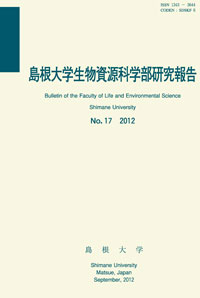島根大学生物資源科学部
ISSN:2435-0885(online)
ISSN:1343-3644(in print)
A publication of this bulletin in print format has not been made since no 24.
ISSN:1343-3644(in print)
A publication of this bulletin in print format has not been made since no 24.

number of downloads : ?
Use this link to cite this item : https://ir.lib.shimane-u.ac.jp/28576
Bulletin of the Faculty of Life and Environmental Science Shimane University 18
2013-09-30 発行
Effect of feeding level and frequency on microbial protein yield in the rumen of growing lambs
File
Description
Two experiments(Expt.I & II)were conducted using growing lambs to investigate the effect of feeding level and frequency on the magnitude of microbes synthesized in the rumen. In Expt. I, the digestion and balance trials were performed on 5-,7- and 9-month-old of the crossbred lambs fed the ration consisted of mixed hay and concentrate(4:6, DM)with 2 and 24 times feeding during consecutive 12 days. The feeding level was 1.2times of requirement for medium growth in lambs. In Expt. II, the same trials were conducted on 5-, 7- and 10-month-old of crossbred lambs fed the ration as Expt. I with 2 and 8 times feeding at 0.6 times of the feeding level in Expt. I. There was no clear difference(P>0.05)in the digestibility of nutrient in both Expts. of I and II. The absorbed nitrogen(N)tended to be more in 24 times feeding than in 2 times feeding at 5-,7- and 9-month-old, and the retained N also tended to be greater in 24 times feeding at 5- and 9-month-old(Expt. I). In Expt. II, there was no clear difference in absorbed and retained N between 2 feeding frequencies. The constant of passage rate of ingesta in the rumen measured in Expt. II tended to high after 8 times of feeding than after 2 times feeding on 7- and 10-month-old. The plasma level and urinary excretion of purine derivatives(PD) were clearly high in Expt. I than in Expt. II, reflecting the difference in feeding level between 2 Expts. In both Expts., daily microbial N supply tended to clearly high after frequent feeding than after feeding twice a day. As a result of reflection of difference in feeding level, the microbial N supply in Expt. I was about2?3times higher than that in Expt. II.
About This Article
Other Article
PP. 29 - 39
PP. 41 - 44
